
How to Use a Policy Loan
Your policy is in force, congratulations! You went through the learning process, got through underwriting, and signed the contract. You paid your premium, and now you can see your cash value available to borrow against staring you in the face on your policy portal. What do you do now…?
This is one of the most common questions we get once a policy goes in force. We focus on the protection and savings component in the ‘protect, save, grow’ order of operations. We are not financial advisors and do not want to be. We are not going to recommend equities or market-exposed products to grow your money, as that is not our lane. We often tell our clients what we are doing to grow our own personal economies, so they can explore different options on their own; but we do not make specific recommendations on how to grow your capital.
There is a sense of urgency that often accompanies the question of how to use newly instantiated cash value, largely due to the pervasive marketing push to always be ‘investing,’ which usually just means forfeiting control to financial institutions. Securing your capital into a contractually guaranteed growth vehicle, and its accompanying rights of access and control, is itself ‘doing something.’ Being well-capitalized and patient, ready to deploy capital as opportunities arise (keeping your powder dry, as they say) is a an advantageous strategy unto itself.
That said, when that opportunity does present itself, it is obviously helpful to understand the mechanics of a policy loan as well as the actual movement of capital as it pertains to your economic ecosystem. We use a simple visual tool to walk through what is happening in the policy loan request and usage process, often drawn on a tablet during a video call. The following is my attempt to walk through this process in a more permanent manner so you can internalize this concept on your own time in order to better utilize our time together on an introductory call. The examples used are from my own policy, with real current numbers. I use round numbers and assumptions to simplify the example, but the numbers and percents are approximately accurate to my current experience. I will note where assumptions are made. I added actual numbers to make the example more illustrative, but don’t get hung up on specific dollar amounts or think you need a certain amount of premium to effectively utilize your policy. We have clients whose annual premium is one fifth of that which I illustrate here, and those who pay five times as much annually; the amount is not important here, the process and the mechanics are.
The Game Board and the Pieces
Let’s start with the initial game board. We need to know both the players and the design of the board in order to successfully win the game. In the financial space, this metaphor works both ways to describe common deficiencies: people either have plenty of pieces (various retirement accounts, brokerage accounts, real estate) but don’t have a game board; or they have a game board (goals and a strategy in place) but no pieces, or no idea which pieces would work in concert to achieve those goals. If you don’t know the rules of the game, how can you know if you are winning? This is why specificity and understanding is so crucial in our relationship with clients. So for the purposes of this article, lets lay out both the players as well as the game board so we can observe the strategy at play.
The three primary players are your policy, the insurance company, and your actual checking account. There are also unknown opportunities that are out there and will seek you out when you are well-capitalized and ready to receive them. The three opportunities that I will walk through in this example demonstrate the actual current investment experience of the growth generated from my policy, but note that when I signed my policy into force, I did not know that any of them existed. I had never even heard of the real estate syndicate or the rental property company who currently provide the cash flow illustrated here, which succinctly proves out Nelson Nash’s creed that capital attracts opportunity. To build out the profile of our three players who exist at the start of the game:
1. Policy cash value
I use the numbers from my actual policy, which is a $50,000 annual premium that is structured as a ‘70/30’ premium, which in this case means 70% of my total premium ($35,000) goes towards PUA while 30% ($15,000) is base premium. These numbers are rounded to make the numbers easier to work with; for those who care, my term rider is external to the stated premium while my waiver of premium rider is included, meaning that rider would very slightly alter these numbers in my actual premium breakdown. The simplified premium total and breakdown is shown in the bottom right of the images moving forward.
2. Insurance company
The blue box in the top left represents the insurance company, specifically their general account. This is going to be an overly simplified representation but one that suffices for our purpose today. What we need to know is that premiums are paid into this account, investments are made, and expenses and liabilities (death benefits) are paid out. Of interest here is the investment component, as policy loans we take are investments to the company, since interest flows to them. Foot-stomper: interest paid on policy loans goes to the company, not your policy! Because we only use mutual companies, we indirectly enjoy that interest paid by contributing to the profitability of a company we own, but if you come to IBC from the dark pit of social media by people trying to oversell a simple product, you may be under the incorrect assumption that you are directly enhancing your policy by paying interest on your policy loans. You are not, and we emphasize that in our content repeatedly due to the rampant proliferation of this misconception.
3. Bank account
While we repeatedly cite Becoming Your Own Banker, we are not actually setting up an actual bank. This point of confusion is common, but easily corrected when we discuss what the banking function is and how we use IBC to control the flow of money into and out of our personal economy. In this example, the checking account is my current personal checking account into which loan funds flow and out of which investment contributions are made.
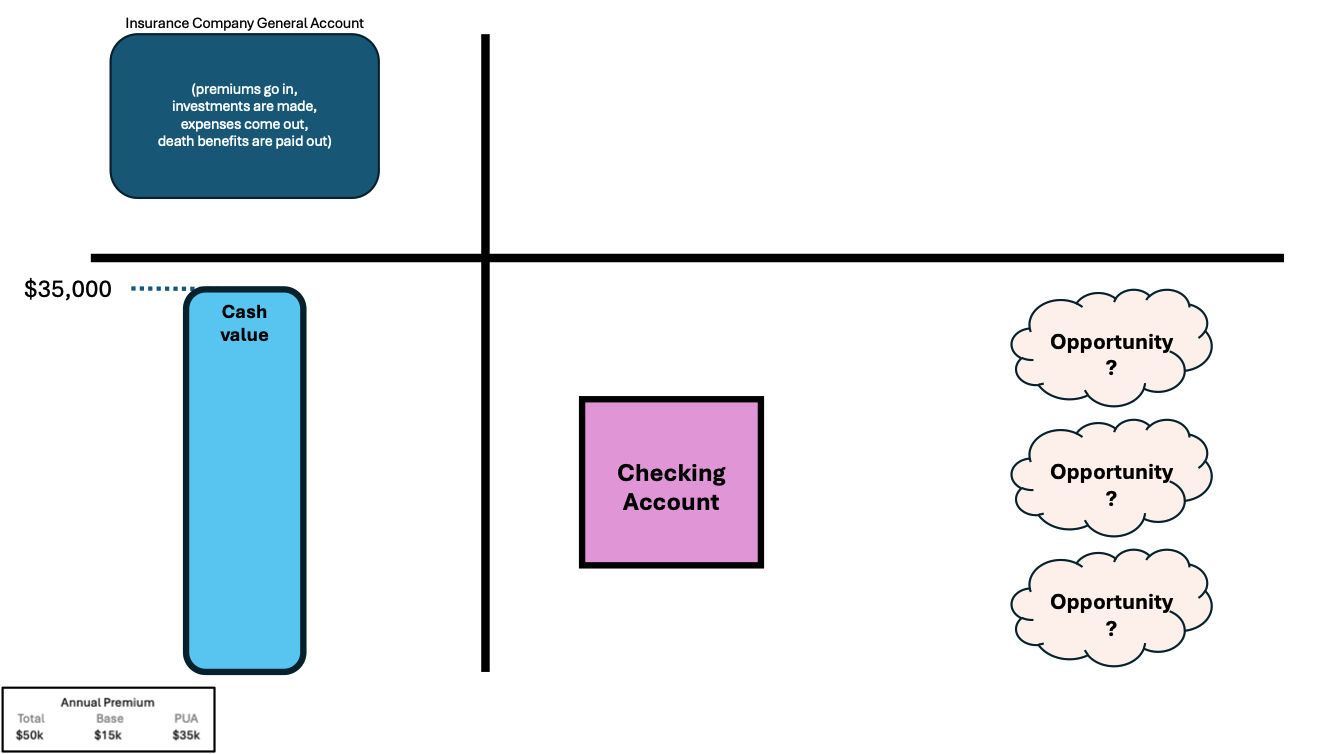
My Capital Attracted Opportunity!
“So what now? I kept my powder dry, and a growth opportunity has come up. I know I can take out a policy loan, but what actually happens and how does the cash flow work on a practical level?"
I’m glad you asked! Let’s continue our walk through. The opportunity that my capital attracted was an opportunity to invest in a real estate syndicate with an operator I knew and trusted. After doing my due diligence, I decided to invest $30,000 into the funding round and received a contract for a return of 10% per year for five years, followed by return of principal along with a proportionate equity stake in the real property acquired via the syndicate. I asked the insurance company for a $30,000 policy loan (which was as simple as logging into my policy holder portal and clicking a few buttons, because remember- no underwriting and automatic approval). Here is how the board looked between the three main players, without bringing in the investment yet.
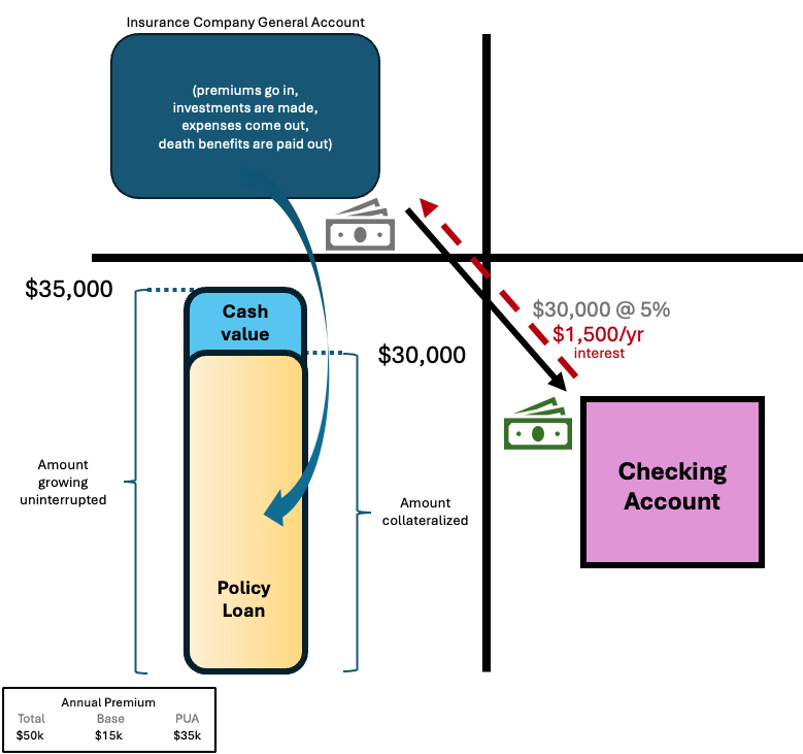
The company loaned me their money, money which actually exists and is fully accounted for in their general account. Contrast this with the fractional reserve lending system of banks and you’ll understand why there is no equivalent run on an insurance company. My $35,000 cash value serves as the collateral for the loan, as indicated by the yellow overlap, but the full amount grows uninterrupted. Compounding interest is a powerful force, but only when it is not interrupted. Down years serve to reduce principal and thus the amount compounded, which is why the average rate of return that is used exclusively in the financial planning industry is a fallacy (see our video on the topic for more detail). The actual money itself comes not from my cash value but from their general account, and into my checking account. The blue arrow from the insurer to my cash value indicates their claim on the portion of my cash value that would be held back if I were to die with the loan outstanding. This ensures they are repaid, eliminating default risk for them (hence the supremely favorable terms of the loans, i.e. no repayment schedule). In effect, they would tell my wife, “we owe you $1m tax free, but Hans asked for an advance of $30,000 in 2023, so we will repay that loan from the death benefit and deliver you the rest.)
The board now stands with my bank account up $30,000 and an outstanding loan balance of the same amount accruing interest at that year’s declared rate, which was 5% in the year I took it. (The companies generally trail the market rate of interest, but whenever you take out a loan the rate is fixed until the next loan anniversary, at which point it is assigned that year’s new rate.) My interest accrual this year is $1,500 (30,000 * .05). My cash value has a collateral assignment against it but is otherwise untouched and growing as if nothing happened. Next, we add the investment piece to see how this opportunity is performing.
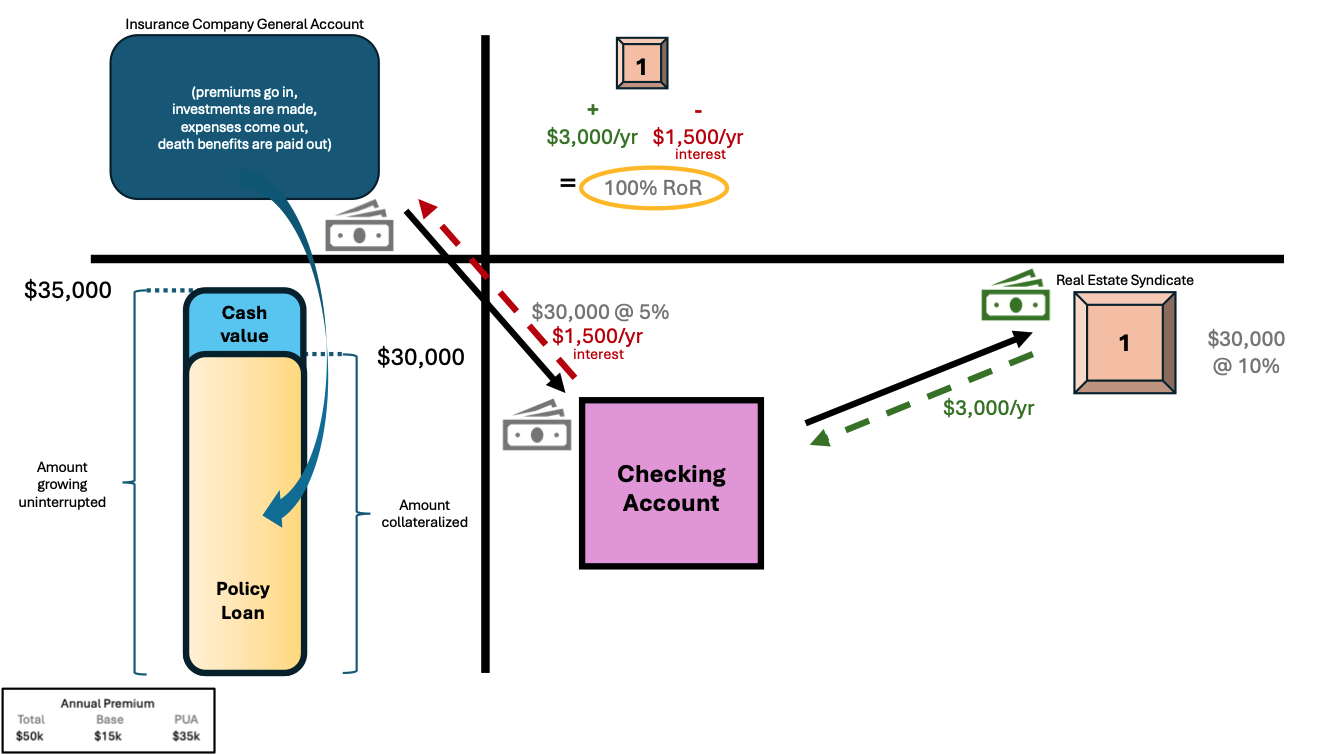
Notice the money went from the insurer to my checking account, then on to the real estate syndicate; there is no graphic of money flowing out of my actual cash value. In exchange for the use of my money, I receive total interest of $3,000 per year. I put none of my own money (directly) into this investment, and have full control over the repayment schedule of the loan. For simplicity’s sake, I will compare the real cost to me (the annual interest accrued) to the actual income earned to determine my rate of return. By that metric, which is the one that matters to me so far as my cash flow is concerned, for every dollar I pay out of pocket to the insurer in the form of interest, I earn two dollars from the investment. This is a 100% rate of return!
Were I to simply pay interest only each year (so that interest on the principal does not compound), the interest income earned would pay interest expense accrued ($1,500) with a full $1,500 left over. With no out of pocket expense, this created $1,500 out of thin air. Of course I had to capitalize my policy, and yes $1,500 itself is not going to move the needle. The purpose here is to demonstrate how to use policy loans and how we can create incredible returns out of your savings vehicle without exposing your principal to risk.
Think about the freedom that comes with building a wall between your principal and your risk exposure; had I moved the $30,000 I had elsewhere directly into the investment, the money is serving one purpose and the success of the investment determines if and how much of my principal I will recover. By flowing that money into the policy first, however, in the form of PUA premium, I isolate the investment risk from that $30,000. In essence, I pay $1,500 for the right to not have the exposure on my principal. But now, if the investment went under, I would have a policy loan outstanding and its interest accruing, but my total cash value of $35,000 grows uninterrupted. I earn dividends on the entire amount, not what is left over after the policy loan. And if I were to walk off the earth early, I would be leaving my wife not just the investment and its return, but a one million dollar tax-free estate as well (less the $30,000 loan + outstanding interest). This is the power of the multiplication effect of our money.
Paying Down the Loan
What I actually did with this policy loan was pay it off in six months, aggressively throwing income at it in order to free up cash value to borrow against for my next investment. My total interest accumulated was $750, so year one return was actually 300% ($3,000 interest in on $750 interest out); in years two through 5 (because it was a five year contract), the return is technically infinite. I view that investment as a small money printer that prints out $3,000 per year for me with no cash outlay. By paying the policy loan down so quickly, I was able to make my entire cash value available for borrowing once again, and began to get the next acquisition processes started. Here is how the board stands after the first loan is paid off; note the illustration of making a loan repayment and what that does to the collateralization of the cash value:
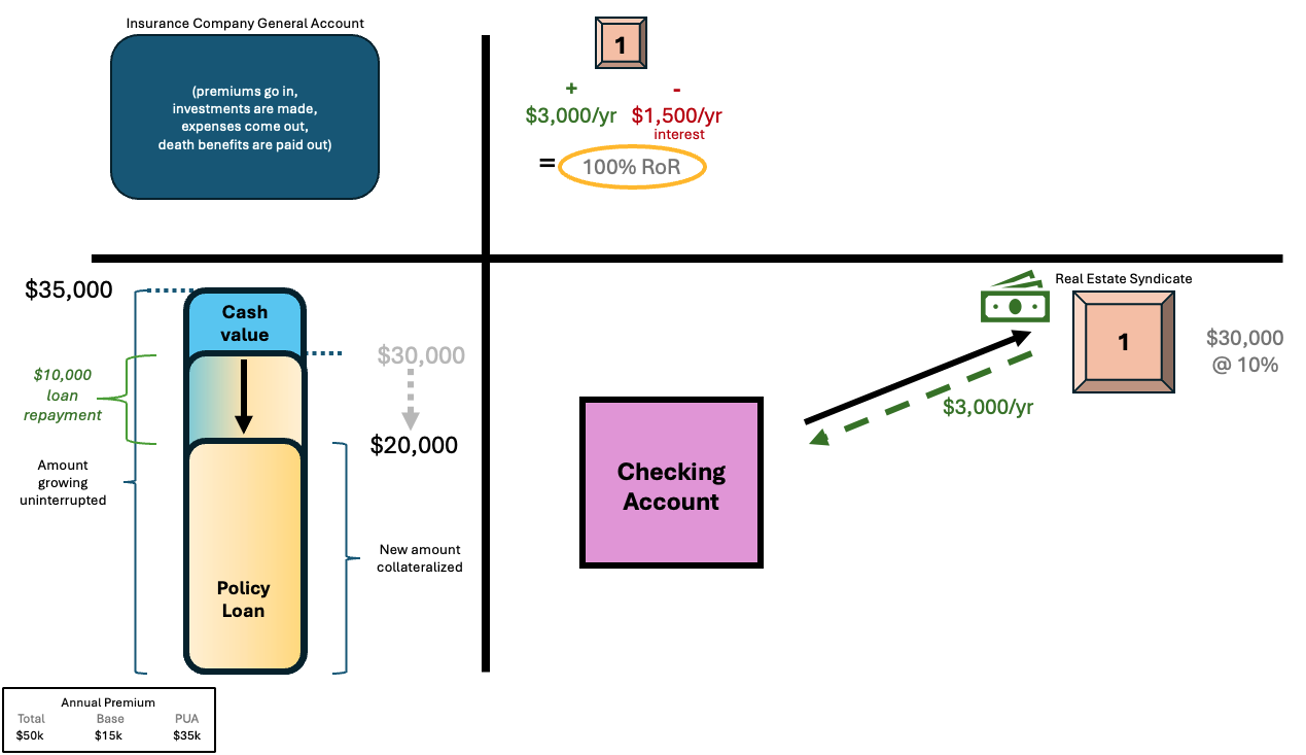
Zooming in on the cash value and policy loan, I’ll sequence out paying down the loan to get a visualization of what is happening as policy loan repayments are made. Remember these are unscheduled loans, so there is no repayment schedule demanded by the company (the power of freedom and control cannot be overstated). I illustrated three $10,000 loan repayments so you can see the loan decreasing and the collateralization along with it, freeing up more to borrow against.

Expanding the System
For investment two, I purchased a turnkey rental property through RP Capital. I want to keep the focus on policy loan usage, but will briefly summarize the terms of the investment so the numbers (which will be rounded for simplicity) make sense. I found a single-family home in Harrisburg, PA for $130,000; I used a $30,000 policy loan to cover the down payment and closing costs, financing the remaining $100,000 with a lender. My tenant pays rent, the same account that receives rent pays the mortgage, and the remaining cash is what I track as my net cash flow. I compare that to the interest I accrue on the policy loan ($1,500, which is my only out of pocket cost here, assuming I opt to pay it) to get my cash flow numbers. Professional real estate investors may prefer other metrics, but I want to know what amount hits my bank account, how much is leftover after the mortgage is paid, and what I have to pay for the right to receive this cash flow. The next visual shows the annual cash flow from the rental property added to the mix.
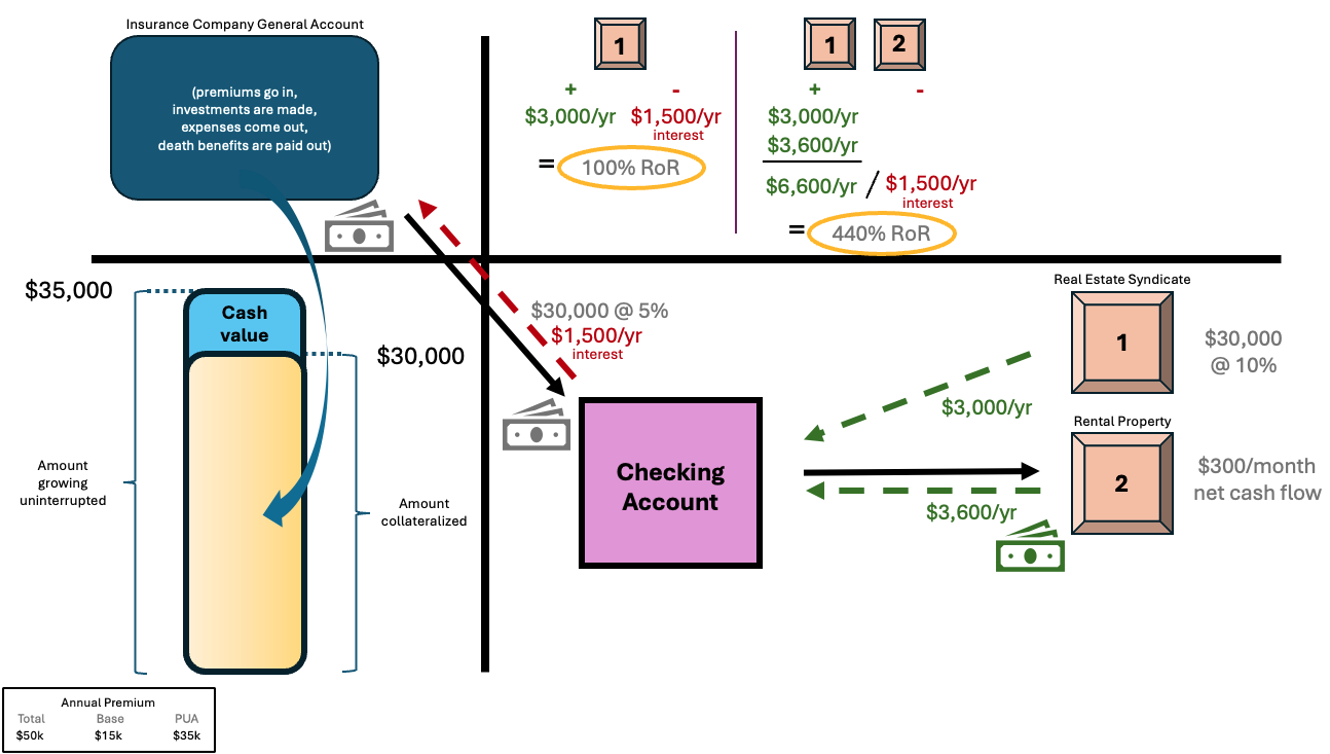
Combined net cash flow is the combination of both investments, offset by the interest accrued, which is back to $1,500 per year with only one loan now outstanding. (Loan balance is combined, not broken out individually in the policy holder portal, but for our purposes today I refer to them as individual loans). Note how rate of return, as I calculate it relative to interest incurred, is now 440%. For every dollar I pay out of pocket towards the policy loan, I earn $4.40. In keeping with Nelson Nash’s charge to be a good banker, I choose to repay my policy loan, not just interest, with the entire cash flow, so I reduce the interest over time as repayments reduce principal. I do not pay interest only to keep the balance static, I just use the numbers as if I did so that I can best isolate the real cost to me out of pocket.
Soon after the acquisition of the rental property, it was my policy anniversary, a day we very much look forward to in the IBC community! My money had been sitting idle in a high-yield savings account, making a bit of interest but serving no other functions. I excitedly put those dollars to work in my policy, and another $35,000 of cash value was generated from that year’s PUA premium. I also got a dividend, which went towards PUA, bringing my total cash value to around $73,000. The visual below shows my loan balance in relation to total cash value throughout this sequence of events. The cash value grew to $73,000 while the outstanding loan, which had been paid down to $20,000 over the prior months, remained the same. In acquiring the second rental property, I took out a policy loan for $40,000, as shown in the visual on the right column. This brought my total loan balance to approximately $60,000, meaning I was accruing $3,000 per year in interest assuming I at least kept the balance static by paying interest.

The numbers for rental two were similar to the first as far as cash flow goes. The property was $140,000 total, and the $40,000 loan applied to down payment and closing costs. The lender covered the remaining $100,000. This one generates a bit more cash each month on average, but also had a water heater which needed replacing, so to date it has a very similar average monthly cash flow of $300. The final image shows the property numbers added to the mix.
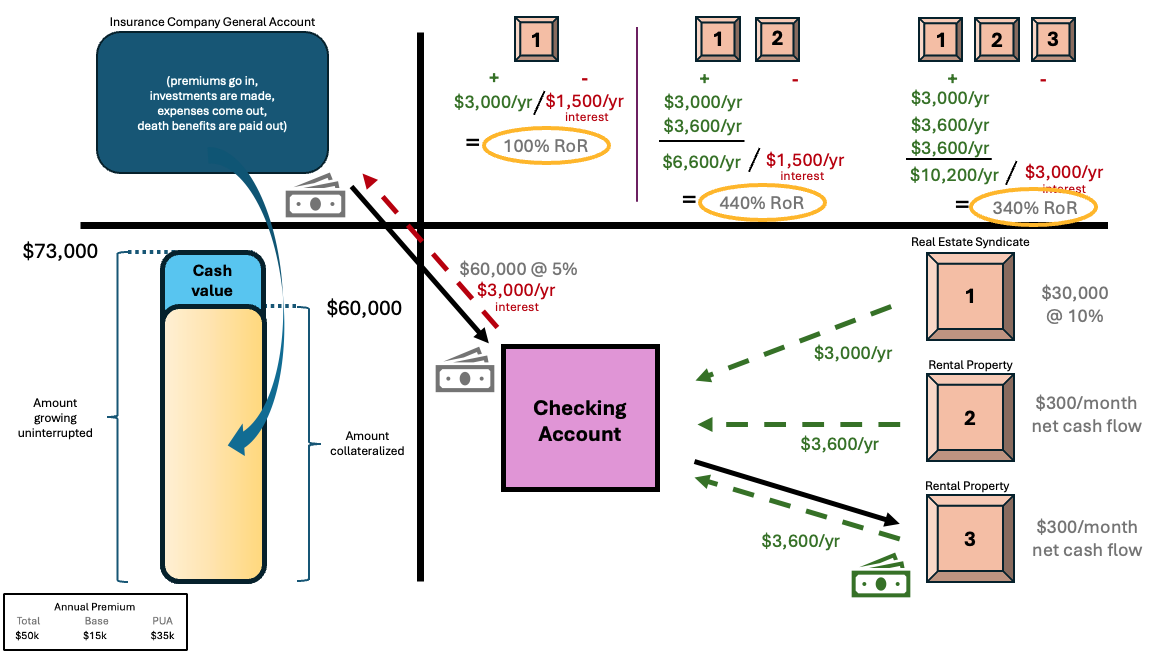
Current Scorecard
The current result is five figures of income generation on an outflow of $3,000. My net rate of return using my metric is 340%, and I have two properties appreciating and paying down their own mortgage. The capital that funded these policies ($100,000) was previously locked up in my TSP (military 401(k)); it was untouchable for three decades and fully subject to the whims of the market without any certainty or guarantees. I provided all the capital and retained all the risk under this system. That did not sit well with me, especially once I learned that banks and financial intuitions value control and access to capital now, outsourcing all risk and not focusing on net worth. That is the exact opposite of the way we are taught to think about money. Rather than allowing someone else to earn money off my capital with the far-off promise to return whatever remains someday, I decided to free my capital from the prison I had sentenced it to. It is now performing as illustrated above, with many more rental properties on the way as I grow my policy and more cash flow enters the system to pay down my outstanding loan balance. When I hit the age where I would have been able to start withdrawing my TSP, I will look at a large portfolio of cash-flowing real estate assets, an enormous cash value I can access guaranteed, and an even larger tax-free estate guaranteed to pay out to my family one day. I will never look back on the $3,000 I had to pay in taxes and penalties to free up that money and put it into motion for me, rather than for a financial institution.
Hopefully the walkthrough of how I am using my policy at least helps you understand the mechanics of the process, if not the numbers. Again, my rate of return calculation is based on the out-of-pocket interest I incur, not total net expenses including loan repayment. That is a personal metric that I use to measure total dollars in and out of my system based on current values; those savvier in real estate valuation may have a much different take on it. The point is not to focus on the specific numbers but the process as a whole. If any of this is unclear and you’d like to discuss further, please reach out to us at [email protected] or hop on our calendar at https://remnantfinance.com/claritycall.
